THE DOGRUN
a place to share ideas
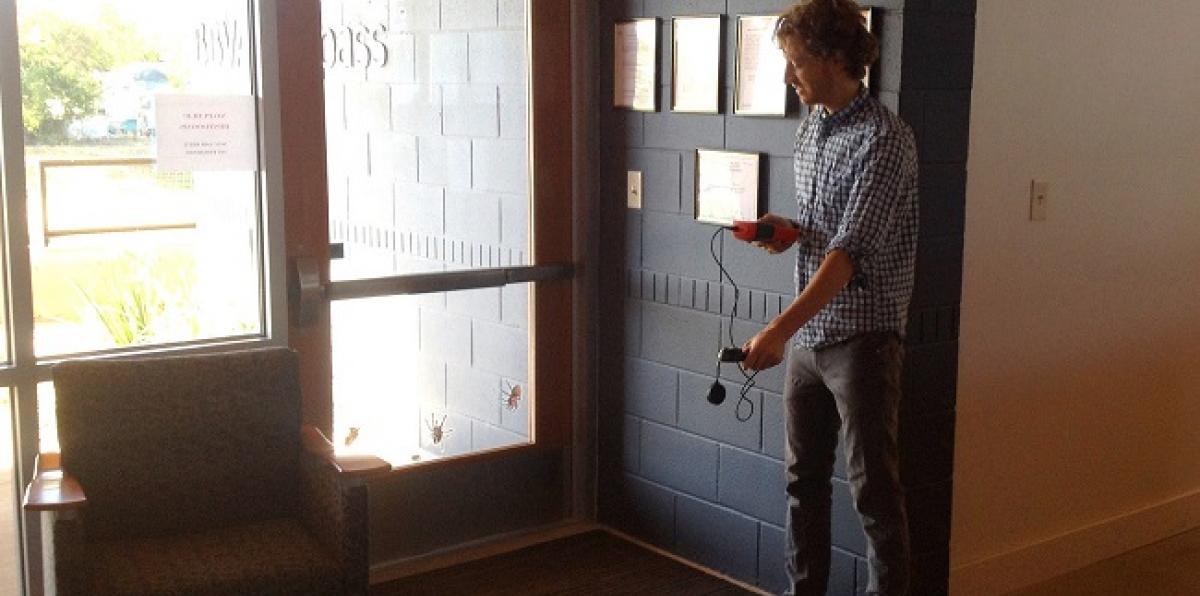

Liftfund Daylight Testing
Posted by AHeisserer on 2/4/16 at 4:10 pm
Last year, we went to the new LiftFund Headquarters in San Antonio to collect daylighting measurements. Collecting real data tells us how accurate our daylighting simulation was, and gives us invaluable information about which strategies are working and which are not.
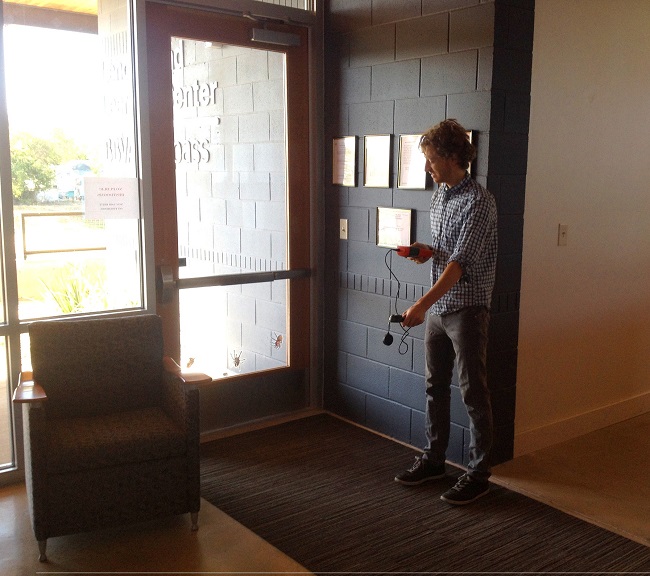 First, we mark off a 5‐foot grid in every regularly occupied space and take a measurement of footcandles at each point with a light meter. Measurements are typically taken at 9 AM or 3 PM, near one of two solar equinoxes.
First, we mark off a 5‐foot grid in every regularly occupied space and take a measurement of footcandles at each point with a light meter. Measurements are typically taken at 9 AM or 3 PM, near one of two solar equinoxes.
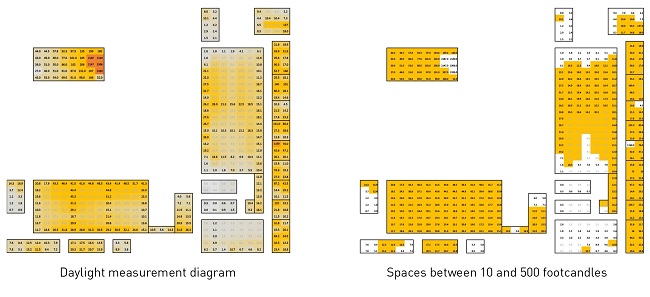 Each data point is entered in Excel, and the missing points are extrapolated from the data we have. Then we have a complete daylight map, and can determine which spaces are appropriately lit. Naturally lit spaces reduce energy demands and create a more comfortable and productive work environment. Exterior views from all regularly occupied spaces also contribute to the enjoyment and visual comfort of the occupants.
Each data point is entered in Excel, and the missing points are extrapolated from the data we have. Then we have a complete daylight map, and can determine which spaces are appropriately lit. Naturally lit spaces reduce energy demands and create a more comfortable and productive work environment. Exterior views from all regularly occupied spaces also contribute to the enjoyment and visual comfort of the occupants.
 The Liftfund building uses several daylighting strategies, including large storefront windows shaded by an exterior walkway, skylights, and vertical punched openings with perforated metal screens. We evaluated the daylighting strategies of six different spaces.
The Liftfund building uses several daylighting strategies, including large storefront windows shaded by an exterior walkway, skylights, and vertical punched openings with perforated metal screens. We evaluated the daylighting strategies of six different spaces.
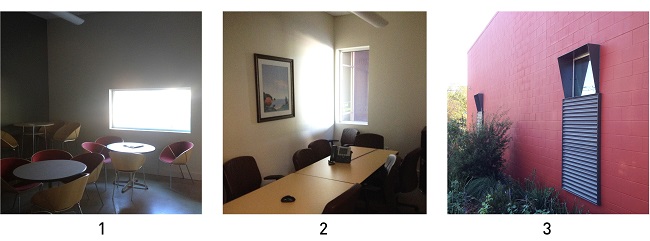 Of the daylighting strategies used, single punched openings were generally the least effective (1) (2).Though all east‐facing windows performed well at the 9 AM testing time, single windows with any other orientation could not independently light the space effectively. The design integrated exterior perforated metal screens on punched windows throughout the project (3). These screens served several critical functions; privacy, security, and solar heat/glare control. With an openness factor of 18% they allow views out from the inside, control the sun’s heat from directly reaching the glass, and prevent glare on computer screens. Our measurements show that these screens do prevent ambient light from reaching far into the room. Louvers may have been an effective strategy for south‐facing windows on another site. A major factor in the low‐performing office spaces were the tall, darkly colored cubicles. They absorb a lot of light unless it comes from a sufficiently high window.
Of the daylighting strategies used, single punched openings were generally the least effective (1) (2).Though all east‐facing windows performed well at the 9 AM testing time, single windows with any other orientation could not independently light the space effectively. The design integrated exterior perforated metal screens on punched windows throughout the project (3). These screens served several critical functions; privacy, security, and solar heat/glare control. With an openness factor of 18% they allow views out from the inside, control the sun’s heat from directly reaching the glass, and prevent glare on computer screens. Our measurements show that these screens do prevent ambient light from reaching far into the room. Louvers may have been an effective strategy for south‐facing windows on another site. A major factor in the low‐performing office spaces were the tall, darkly colored cubicles. They absorb a lot of light unless it comes from a sufficiently high window.
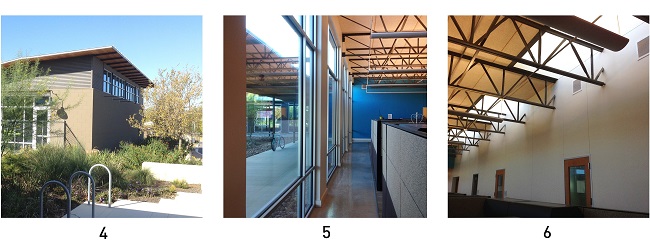 Spaces with clerestories (4), shaded floor‐to‐ceiling storefront windows (5), or skylights (6) performed very well. Any spaces with high, wide, north‐facing windows were perfectly lit.
In summary:
‐High horizontal windows are generally better than low vertical windows
‐One small punched window is usually not enough
‐If and when possible, cubicle height should be kept low
‐North‐facing clerestories brought in an abundance of soft, balanced light.
Spaces with clerestories (4), shaded floor‐to‐ceiling storefront windows (5), or skylights (6) performed very well. Any spaces with high, wide, north‐facing windows were perfectly lit.
In summary:
‐High horizontal windows are generally better than low vertical windows
‐One small punched window is usually not enough
‐If and when possible, cubicle height should be kept low
‐North‐facing clerestories brought in an abundance of soft, balanced light.
 First, we mark off a 5‐foot grid in every regularly occupied space and take a measurement of footcandles at each point with a light meter. Measurements are typically taken at 9 AM or 3 PM, near one of two solar equinoxes.
First, we mark off a 5‐foot grid in every regularly occupied space and take a measurement of footcandles at each point with a light meter. Measurements are typically taken at 9 AM or 3 PM, near one of two solar equinoxes.
 Each data point is entered in Excel, and the missing points are extrapolated from the data we have. Then we have a complete daylight map, and can determine which spaces are appropriately lit. Naturally lit spaces reduce energy demands and create a more comfortable and productive work environment. Exterior views from all regularly occupied spaces also contribute to the enjoyment and visual comfort of the occupants.
Each data point is entered in Excel, and the missing points are extrapolated from the data we have. Then we have a complete daylight map, and can determine which spaces are appropriately lit. Naturally lit spaces reduce energy demands and create a more comfortable and productive work environment. Exterior views from all regularly occupied spaces also contribute to the enjoyment and visual comfort of the occupants.
 The Liftfund building uses several daylighting strategies, including large storefront windows shaded by an exterior walkway, skylights, and vertical punched openings with perforated metal screens. We evaluated the daylighting strategies of six different spaces.
The Liftfund building uses several daylighting strategies, including large storefront windows shaded by an exterior walkway, skylights, and vertical punched openings with perforated metal screens. We evaluated the daylighting strategies of six different spaces.
 Of the daylighting strategies used, single punched openings were generally the least effective (1) (2).Though all east‐facing windows performed well at the 9 AM testing time, single windows with any other orientation could not independently light the space effectively. The design integrated exterior perforated metal screens on punched windows throughout the project (3). These screens served several critical functions; privacy, security, and solar heat/glare control. With an openness factor of 18% they allow views out from the inside, control the sun’s heat from directly reaching the glass, and prevent glare on computer screens. Our measurements show that these screens do prevent ambient light from reaching far into the room. Louvers may have been an effective strategy for south‐facing windows on another site. A major factor in the low‐performing office spaces were the tall, darkly colored cubicles. They absorb a lot of light unless it comes from a sufficiently high window.
Of the daylighting strategies used, single punched openings were generally the least effective (1) (2).Though all east‐facing windows performed well at the 9 AM testing time, single windows with any other orientation could not independently light the space effectively. The design integrated exterior perforated metal screens on punched windows throughout the project (3). These screens served several critical functions; privacy, security, and solar heat/glare control. With an openness factor of 18% they allow views out from the inside, control the sun’s heat from directly reaching the glass, and prevent glare on computer screens. Our measurements show that these screens do prevent ambient light from reaching far into the room. Louvers may have been an effective strategy for south‐facing windows on another site. A major factor in the low‐performing office spaces were the tall, darkly colored cubicles. They absorb a lot of light unless it comes from a sufficiently high window.
 Spaces with clerestories (4), shaded floor‐to‐ceiling storefront windows (5), or skylights (6) performed very well. Any spaces with high, wide, north‐facing windows were perfectly lit.
In summary:
‐High horizontal windows are generally better than low vertical windows
‐One small punched window is usually not enough
‐If and when possible, cubicle height should be kept low
‐North‐facing clerestories brought in an abundance of soft, balanced light.
Spaces with clerestories (4), shaded floor‐to‐ceiling storefront windows (5), or skylights (6) performed very well. Any spaces with high, wide, north‐facing windows were perfectly lit.
In summary:
‐High horizontal windows are generally better than low vertical windows
‐One small punched window is usually not enough
‐If and when possible, cubicle height should be kept low
‐North‐facing clerestories brought in an abundance of soft, balanced light.
